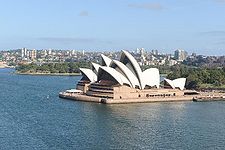Communication and Media Richness Assurance in High-performance Projects
Case Studies
Having studied a selection of commonly used communication media, a look at how project communication in industry affects project success/failure classification may be interesting. In the following section three case studies are compared and contrasted in terms of their final delivery outcome and the impact in-project communication has had thereupon. The case studies have been selected based on shared project similarities and their varying degree of project communication success, ranging respectively from poor through adequate to good.
Sydney Opera House

The Sydney Opera House opened in 1973 at a central setting in Sydney Harbour. While the result of a mere 15 years' work[2], the building represented a leap in construction technology of several decades owing to both its structural design and material engineering.
Rewinding time a little, in 1966 the chief architect Jørn Utzon was forced to resign over questions to his designs aired by the minister of works Davis Hughes[3]. There was a public outcry over the situation, but Utzon was not reinstated and was succeeded by another chief architect, Peter Hall. Hughes informs the public that there is a new architect team on the case, and Utzon tells the new chief architect "I don't think you can do it, I think you're a brave man to try, but I'm not going to be involved anymore"[4].
A few years prior to this, Hughes had started to develop alternative project leadership thoughts. "By August 1965, Hughes had formulated a strategy to take control of the project, devising a plan based on his own convictions and supported by opinions from a range of individuals. Foremost among these was the bureaucratic method favoured by Bill Wood...Bill Wood's report to Hughes resurrected the text book bureaucratic solution of "cheque book control". Intentionally or not, it was designed to get rid of Utzon by stripping him of his authority as project director"[5].
Forwarding time, "in 2007 the Sydney Opera House was formally recognised as one of the most outstanding places on Earth with its inclusion on the UNESCO World Heritage List under the World Heritage Convention"[3].
The communication in this case study example between the respective project heads (minister of works and two chief architects) is very multi-faceted. Listing it as a series of time-ordered events may aid clarification for summarising purposes: 1. Utzon does his job on the project without mentionable communication directed at Hughes 2. Hughes has alternative project plans, and exercises power to excute these 3. Hall contacts Utzon to obtain information prior to accepting the job as new chief architect 4. Utzon ushers Hall by use of some potentially strategically intended use of language
The situation could be considered critical: A construction project worth AUD $102 million[6] at the centre of Worldwide public attention halted jointly by a politically pivotal project leadership decision and, more crucially, a high-risk change of resource-scarce architectural mastermind supervision.
From the project scenario, four points could be concluded: - Situation: The project met a crisis involving management strategy, project planning and internal communication - Communication effected: internal stakeholder communications were partly exchanged and partly omitted, leaving involved parties at various levels of understanding - Action taken: Problem ratification was quick and effective yet messy; the project continued without mentionable losses in time and cost, but serious losses in human integrity - Ultimate project success: The opera house commissioning project could be considered a success, despite misses in targets and various losses along the way
Key Points:
The higher the risk, the more important communication becomes
Action speaks louder than words (get away with errors in verbal communication, as non-verbal communication through action is more important)
Transparency, openness and honesty in project management usually provide better results than hidden agendas and unaired/undebated problems.
References
- ↑ Traveluto (2017). 8 Most Famous Landmarks in Australia, [Online], Available at: https://traveluto.com/famous-landmarks-in-australia/ [First accessed 1 March 2019]
- ↑ UNESCO (1992-2019). Sydney Opera House, [Online], Available at: https://whc.unesco.org/en/list/166 [First accessed 1 March 2019]
- ↑ 3.0 3.1 Sydney Opera House. The Architect: Jørn Utzon, [Online], Available at: https://www.sydneyoperahouse.com/our-story/the-architect-jorn-utzon.html [First accessed 1 March 2019]
- ↑ Ben Cheshire, Greg Hassall (2018). The man who fixed the 'plain illegal' Sydney Opera House, [Online], Available at: https://www.abc.net.au/news/2016-01-31/peter-hall-architect-who-fixed-opera-house-after-utzon-departed/7127160 [First accessed 1 March 2019]
- ↑ Sam Doust (2012). Chapter 18: The Tenacity of Davis Hughes, [Online], Available at: http://theoperahouseproject.com/ie/transcripts/The-Tenacity-Of-Davis-Hughes.htm [First accessed 1 March 2019]
- ↑ Sydney Opera House. Interesting facts about the Sydney Opera House, [Online], Available at: https://www.sydneyoperahouse.com/our-story/sydney-opera-house-facts.html [First accessed 1 March 2019]